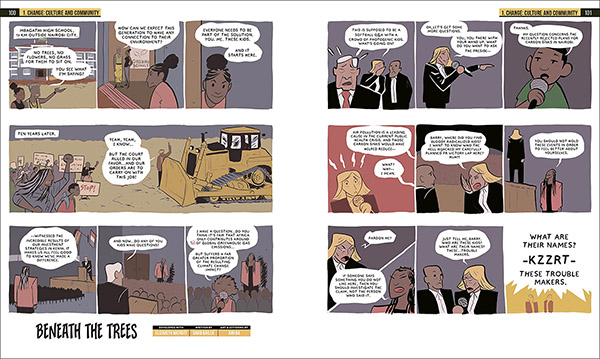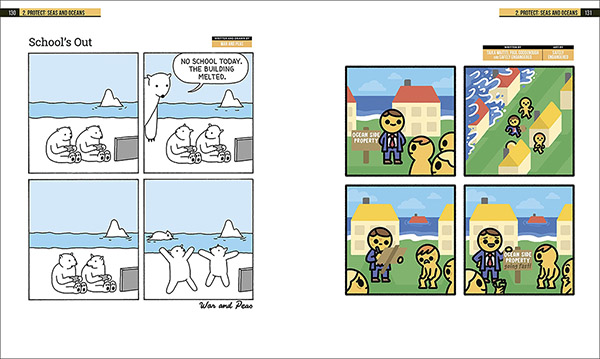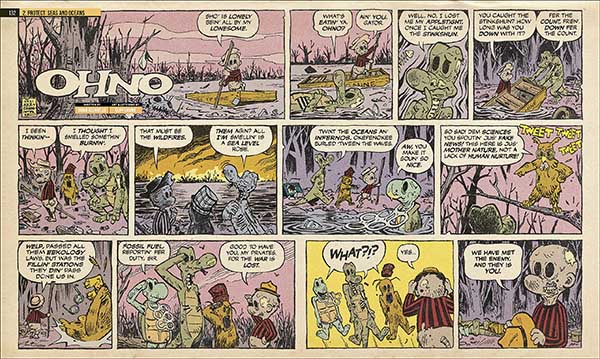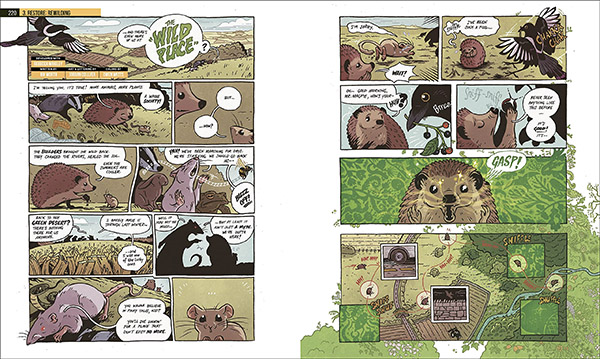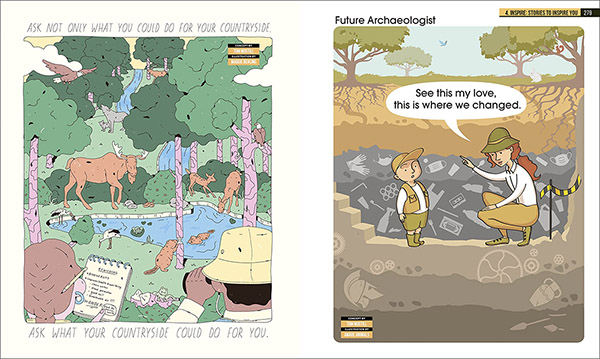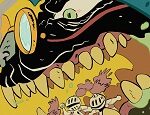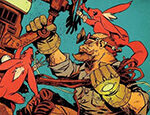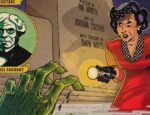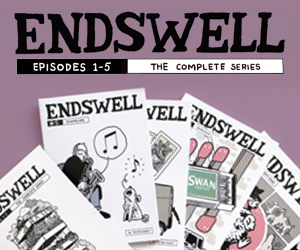EARTH DAY WEEK! Where does one even begin with attempting to review such a colossal group effort as Dorling Kindersley’s The Most Important Comic Book on Earth: Stories to Save the World? Over 300 contributors including comic creators, environmentalists, actors, musicians and authors, nearly 350 pages, and over 120 strips of varying lengths, approaches and styles. It’s a remarkable logistical achievement, all overseen by editor and art director Paul Goodenough.
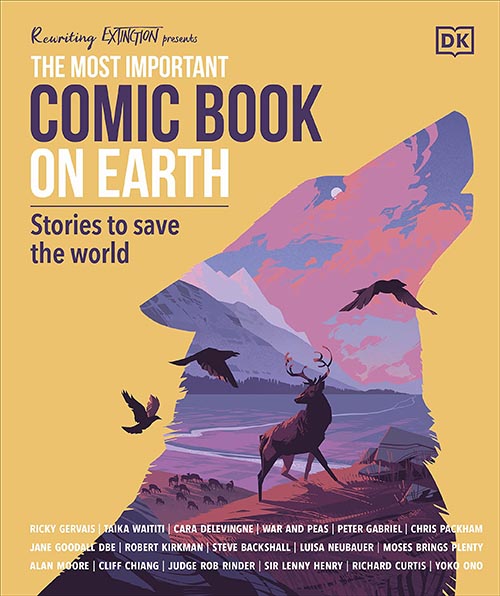
What marks out The Most Important Comic Book on Earth in comparison to other ecologically-themed comics anthologies is its careful structuring into relevant sections. Rather than a spontaneous but unfocussed free-for-all it instead places work in four main chapter areas – Change the System, Protect the World, Restore the Damage, Inspire and Educate – each of which are then broken down into sub-sections.
Stories cross genres. Understandably there’s a lot of graphic journalism but there’s also biography, personal testimony, humour, parody, parable and genre fiction. Interspersed throughout are text features providing further information on the issues raised. These include fact pages, interviews and information for readers on how they can make a difference with practical action.
David Baillie and Juni Ba
There are many celebrity names attached to the project (Cara Delevingne, Ricky Gervais, Lenny Henry, Chris Packham, Lucy Lawless and Yoko Ono to name a few) which no doubt has served a worthy purpose in raising the book’s profile. The standout work though comes from the direction of the comics creatives involved who range from the bigger-name, mainstream monthly comics world to small pressers and indie artists.
In a book of the scope of The Most Important Comic Book on Earth picking out just a handful of stories to comment on is a necessity but one that also feels a little churlish in approach. But the examples that follow will hopefully give an idea of the how the anthology’s diversity of styles ensures that readers connect with its pages in a variety of different ways; whether that be through the cutting tone of satirical comedy or the anger provoked by tales of ecological devastation.
Early on writer Paul Goodenough and artist Serg Acuña (with letterer Bernardo Brice) give us a plea for immediate action in ‘Make Earth Great Again’; one that subverts Trumpian rhetoric with a far more appealing slogan/acronym. Addressing the importance of people power John Wagner shares a number of personal accounts from environmental activists with an emphasis on the Extinction Rebellion movement. It’s a pertinent reminder that concern about climate change crosses demographics, with Leonardo Marcello Grassi’s photorealistic art embodying the harsh truths involved.
War and Peas (left) and Taika Waititi, Paul Goodenough and Safely Endangered (right)
The toxicity of consumerism/capitalism on the world around us gets attention in its own sub-section. There’s a memorable short ‘Own the Skies’ from writer Rob Williams with appropriately atmosphere-building muted colours from artist Ben Oliver that predicts a future where corporations own clouds and thus the rain that is essential to crops. Where The Most Important Comic Book on Earth excels is in alerting readers to information that may be new to them. The destructive ramifications of the fast fashion industry, for example, or how your pension fund money is used in ethically questionable investments without your knowledge.
Rising star of the moment Zoe Thorogood illustrates Sarah Florence Lord’s story ‘Lessons from the Lakota’ (again, as with the stories above, with lettering from Bernardo Brice). Providing indigenous wisdom about working in partnership with nature, it asks us to stop thinking of the Earth as our resource and instead as the source of all life. Thorogood’s intuitive colour choices here fluently communicate the tone and themes of the strip.
In the Protect the World section Brian Azzarello and Danijel Zezelj present ‘The Shepherd and the Thunder’ in collaboration with activist Peter Hammarstedt, highlighting the work of the Sea Shepherd organisation in protecting marine life (also covered in Sean Azzopardi’s The Sea Shepherd comic a year or two back). Zezelj’s dark, moody, black and white art here really capturing the brutality of the illegal fishing industry. Azzarello is also responsible for ‘Ohno’ (above) which revisits the swamp environs of Walt Kelly’s classic newspaper strip character Pogo in a future where they have been destroyed by pollution and toxic waste. Cliff Chiang’s art makes this one of the most striking strips in the entire book with familiar and much loved characters being reduced to shambling messes hammering home the message.
There is a constant refrain in The Most Important Comic Book on Earth that what we take for granted has a cost, whether that be deforestation, pollution or the ever present plastic threat. One of the finest “language of comics” examples of this is Amy Meeks’ ‘Torn’ which after an initial panel sees a rip down the page displaying two futures – one where we tackle climate change and environmental disaster and one where we don’t.
It’s not only impact and consequence that get time here there’s also a focus on the positive and the possible. The team of Rik Worth, Jordan Collver and Owen Watts (above) look at rewilding from the perspective of the wildlife it benefits in a story with a denouement that still emphasises the ominous in any hint of the hopeful. Paul Goodenough and Geoff Senior (with letters from Jim Campbell) give us a more domestic look at biodiversity in ‘Untidy’ as a young boy transforms the family garden from sterile order to unkempt beauty. What could have come across as saccharine and twee instead feels rewarding and motivating in this well-paced 6-pager.
Tom Mustill and Maggie Behling (left) and Tom Mustill and Aware Animals (left)
The final section gives us stories to inspire, not the least of which is Philip Sevy’s look at the life of young activist Elizabeth Finley Broaddus who, after a cancer diagnosis in her teenage years, spent her remaining time working to raise environmental consciousness. In just four short pages Sevy introduces us to a remarkable young woman, her legacy, and gives us something so inspiring that the reader immediately wants to investigate further.
The Most Important Comic Book on Earth: Stories to Save the World is surely the go-to comics collection for explorations of green issues. Whether it be the grim post-apocalyptic future of Kirkman and Adlard’s ‘A Glimpse’ or the madcap humour of Lew Stringer’s resurrection of his Pedantic Stan the Comics Fan character the breadth of approaches to the subject matter is quite stunning in its delivery. A book that should be on the shelves of every library for its accessible and comprehensible breakdown of the issues involved.
Anthology – Various creators • Dorling Kindersley, £20.00
Review by Andy Oliver





